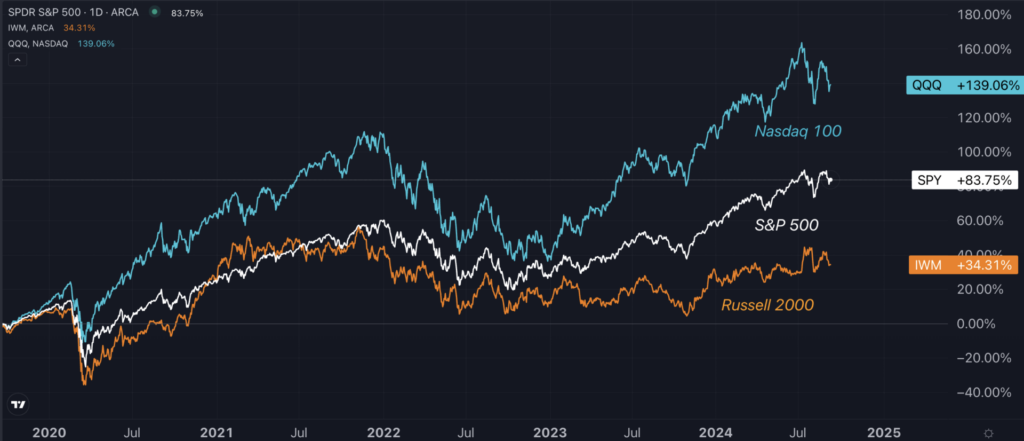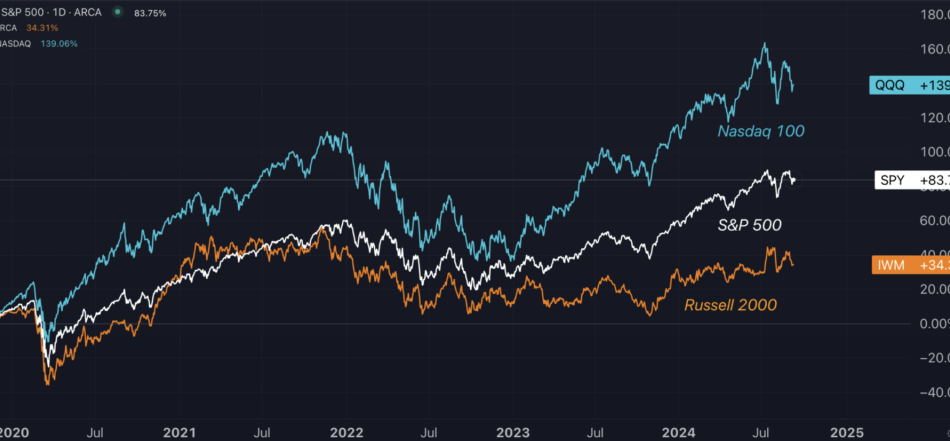EXCLUSIVE: Lazard Small-Cap Expert Predicts 30%-50% Russell 2000 Rally On The Back Of Lower Interest Rates (UPDATED)
Editor’s note: This story has been updated to clarify that an expectation of up to 200 basis points of interest rate cuts over the next year is the view of Sean Gallagher and not of Lazard itself.
Small-cap stocks may be poised for a powerful catch-up rally in the next six to 12 months, especially as interest rates begin to decline, according to Sean Gallagher, global head of Lazard‘s small-cap equity platform.
After years of sharp underperformance relative to large caps, Gallagher predicts that small caps, as tracked by the iShares Russell 2000 ETF IWM, are set to rally between 30% and 50% in the upcoming year, closing the gap with large-cap counterparts.
In an exclusive interview with Benzinga, Gallagher stressed the striking valuation gap between small and large caps, a key factor supporting his bullish outlook.
“Small caps have been lagging significantly for an extended period,” he said.
A Catalyst For Small Caps: Lower Interest Rates
Gallagher’s optimism centers on the Federal Reserve’s expected pivot towards rate cuts, a shift that could provide small caps with the tailwind they need to outperform.
“We feel very good that inflation is on a downward trajectory, and we expect the Federal Reserve to begin cutting rates soon. This should provide a much-needed catalyst for small caps to catch up with large caps,” he said.
Gallagher said he anticipates up to 200 basis points of rate cuts over the next year, which he said could significantly lift small-cap stocks, given their higher leverage and sensitivity to borrowing costs.
Chart: Russell 2000’s Sharp Underperformance vs. S&P 500, Nasdaq 100 Over The Past 5 Years

Valuation Gap Creates Opportunity
One of the primary reasons for Gallagher’s bullish stance is the sheer size of the valuation gap between small and large caps. “The median price-to-earnings (PE) ratio for small caps, excluding non-earners, stands at 9.5 times, which is incredibly attractive compared to large caps,” he said.
While the broader small-cap index might seem less compelling at first glance, Gallagher noted that the roughly 18% of small-cap companies that are non-earners skew the overall picture. “When you remove the non-earners from the index, small caps look exceptionally cheap,” he added.
The numbers are striking: Small caps have underperformed the S&P 500 by 10 percentage points this year, 30% over the past three years, and nearly 50% over the past five years.
Sector Focus: Financials, Health Care, and Consumer Durables
When it comes to Lazard’s small-cap strategy, Gallagher noted that the portfolio is heavily weighted toward sectors that will benefit the most from a lower interest rate environment.
“We are particularly bullish on financials, healthcare, and consumer durables,” he said.
Health care spending, especially in biotech, has been muted recently, but Gallagher said lower borrowing costs could reignite investment in this area.
He also sees significant potential in consumer durables, especially companies with debt-heavy balance sheets, which stand to benefit from reduced financing costs. “Many consumer durables companies have felt the impact of elevated rates, but we expect them to rebound strongly as borrowing costs decline,” he added.
A Republican Sweep Could Favor Small Caps
Gallagher also touched on the potential political implications for small-cap stocks, particularly with the upcoming 2024 U.S. presidential election.
Historically, small caps have fared better under Republican administrations, which tend to favor lower taxes and pro-market policies.
“While the election outcome remains uncertain, a Republican-led White House could be a tailwind for small caps, especially if it leads to tax cuts or reduced regulation,” Gallagher stated.
It’s worth noting that Goldman Sachs analysts predict stronger GDP and job growth if Democrats sweep the White House and Congress.
Recession Risk And Fed Missteps
Despite his overall bullishness, Gallagher acknowledged several risks that could derail the small-cap rally.
Chief among them is the potential for the Federal Reserve to fall behind the curve in addressing economic softening. “We’re seeing some signs of economic slowdown, particularly in consumer and industrial sectors, but it’s not flashing recession to me just yet,” he said.
Gallagher emphasized the importance of the Fed acting swiftly to cut rates, ensuring the economy doesn’t lose too much momentum before the rate cuts take effect. “We just need to get from here to there, and as long as the Fed acts in time, I believe we can avoid a significant contraction,” he added.
Now Read:
Don’t miss the opportunity to dominate in a volatile market at the Benzinga SmallCAP Conference on Oct. 9-10, 2024, at the Chicago Marriott Downtown Magnificent Mile.
Get exclusive access to CEO presentations, 1:1 meetings with investors, and valuable insights from top financial experts. Whether you’re a trader, entrepreneur, or investor, this event offers unparalleled opportunities to grow your portfolio and network with industry leaders.
© 2024 Benzinga.com. Benzinga does not provide investment advice. All rights reserved.


Leave a Reply